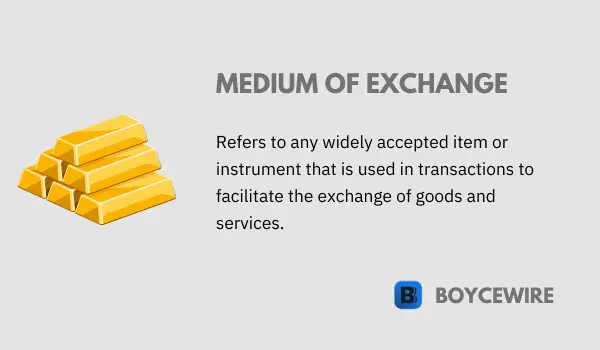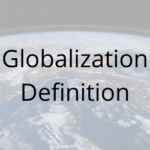Medium of Exchange: Definition, Types & Examples

What is a Medium of Exchange?
In every economy, one fundamental problem that must be solved is the facilitation of exchange. People need a way to trade goods and services with one another in an efficient and fair manner. To solve this problem, societies have adopted the concept of a “medium of exchange” – an intermediary instrument or system used to facilitate the sale, purchase, or trade of goods between parties.
A medium of exchange is one of the primary functions of money, serving as a widely recognized tool that can be exchanged for goods and services. From ancient civilizations using gold, silver, and other precious commodities to modern economies utilizing digital currencies, the concept of a medium of exchange has played a crucial role in fostering trade and economic growth.
Key Points
- A medium of exchange is a fundamental function of money, enabling the exchange of goods and services.
- It serves as a universally accepted method of payment, eliminating the need for barter or direct exchange.
- Mediums of exchange can take various forms, including physical currency, digital payment methods, and cryptocurrencies.
Understanding Medium of Exchange
A medium of exchange is an intermediary instrument or system used to facilitate the sale, purchase, or trade of goods and services between parties. It is anything that is widely accepted in exchange for goods and services. This idea lies at the heart of modern economic systems because it eliminates the inefficiencies of a barter system where goods and services are directly exchanged for one another, which requires a coincidence of wants.
Money, in its many forms, is the most common medium of exchange. It is an accepted payment method within a specific geographic region or community, for all transactions, irrespective of the nature of goods or services being exchanged.
The medium of exchange serves several key functions:
- Elimination of Barter System: A medium of exchange eliminates the need for a coincidence of wants, a problem inherent in the barter system. For instance, if a farmer who has an excess of wheat wants to trade it for milk, he needs to find a dairy farmer who needs wheat. With a medium of exchange, this direct exchange isn’t necessary, and trading becomes simpler and more efficient.
- Common Measure of Value: A medium of exchange provides a common measure of value, enabling individuals to ascertain the market value of goods or services easily. It helps in comparing the values of different goods and services, thereby facilitating a more efficient allocation of resources.
- Standard of Deferred Payments: It allows for the deferral of payments, as it is generally acceptable and retains its value over time. This function is critical for lending, financing, and any situation involving future payments.
While money is the most prevalent medium of exchange in modern times, the concept isn’t limited to just cash, coins, or banknotes. With advancements in technology and changes in societal norms, mediums of exchange have evolved to include digital payments, cryptocurrencies, and even non-monetary items like gift cards, reward points, and barter systems in specific communities or circumstances. In the next section, we will look at these different types of mediums of exchange in greater detail.
Types of Medium of Exchange
A variety of items or systems can serve as a medium of exchange, as long as they are generally accepted within a community for the exchange of goods and services. Here are the main types:
Commodity Money
This is the earliest form of a medium of exchange, where commodities that have intrinsic value, such as gold, silver, or other precious metals, were used. Even items like shells, salt, or cattle have been used as commodity money in various societies. These commodities were chosen for their durability, divisibility, and transportability, and their value didn’t rely on any government decree.
Fiat Money
This is what we commonly recognize as money today – the coins and banknotes issued by a government. Unlike commodity money, fiat money has no intrinsic value; its value comes from the trust and confidence people have in the government authority that issues it. Fiat money is declared to be legal tender, which means it is recognized by the government as a valid medium of exchange for settling debts.
Bank Money
Bank money refers to the credits and debits in bank accounts, which can be transferred for transactions. These are virtual funds and are widely used in the modern economy. They can be accessed and transferred using checks, debit cards, credit cards, or electronic transfer systems.
Cryptocurrencies
With the rise of digital technologies, a new form of a medium of exchange emerged – cryptocurrencies. The most famous example is Bitcoin, but there are thousands of other digital currencies. Cryptocurrencies use cryptography for security and operate on decentralized networks based on blockchain technology. They are not typically issued or regulated by any government or central authority.
Non-Monetary Items
In certain contexts, non-monetary items can act as a medium of exchange. Examples include airline miles, credit card reward points, gift cards, or in-game currency in online gaming platforms. These are typically restricted to certain communities or platforms but serve the same function of facilitating transactions.
Properties of a Good Medium of Exchange
While a medium of exchange can take on many different forms, there are certain properties that make some items more effective at facilitating transactions than others. An effective medium of exchange should typically have the following characteristics:
- Divisibility: It should be divisible into smaller units without loss of value. This allows for flexibility in transactions, so people can make purchases of varying sizes. For example, a currency is divisible because you can make change with smaller denominations of bills and coins.
- Durability: The medium of exchange should be durable and not degrade over time. This is important because if it wears out too quickly, it will lose its value. Coins and banknotes, for example, are made of sturdy materials that can last for years.
- Portability: It should be easy to carry around, so that it can facilitate transactions in different locations. Digital forms of money, like bank money and cryptocurrencies, are particularly portable because they can be carried virtually on a mobile device or card.
- Uniformity: Every unit of the medium of exchange should be the same as every other unit. This property is crucial for it to be a common measure of value. For example, every one-dollar bill has the same value as every other one-dollar bill.
- Limited in Supply: A good medium of exchange should be limited in supply to maintain its value. If it’s too abundant or can be easily produced, it would lead to inflation and the medium of exchange would lose its purchasing power.
- Acceptability: Perhaps most importantly, a medium of exchange must be generally accepted by the people who are expected to use it. People must have faith that it will be accepted by others in exchange for goods and services.
These properties are ideals, and not all mediums of exchange possess all these properties perfectly. However, the closer a medium of exchange can come to satisfying these properties, the more effective it will be.
Evolution of Medium of Exchange
The concept of a medium of exchange has evolved significantly throughout history, adapting to the changing needs and technologies of society. Here’s a brief look at its progression:
- Barter System Before the invention of money, people relied on the barter system, directly exchanging goods and services. However, this system was inefficient due to the “double coincidence of wants” problem – the need for both parties to want what the other has to offer.
- Commodity Money Over time, societies began to use commodities with intrinsic value, like gold, silver, salt, and cattle, as a medium of exchange. These commodities were chosen due to their durability and divisibility, but carrying large amounts was often inconvenient and unsafe.
- Metal Coins and Paper Money The first coins were introduced in ancient times, made from precious metals like gold and silver. Later, paper money was introduced, initially as a form of receipt representing commodities stored in the bank. Eventually, the intrinsic value of the money itself became less important than the value it represented.
- Fiat Money With the rise of nation-states, governments started issuing fiat money – currency that has value because a government maintains its value, or because two parties agree on its value. Modern paper currencies and coins are examples of fiat money.
- Bank Money With the advent of banking, most money became digital, existing as entries in bank accounts. This bank money could be transferred using checks or electronic transfer systems. Credit and debit cards also became popular, representing a promise to pay money stored elsewhere.
- Cryptocurrencies The latest evolution in mediums of exchange is cryptocurrencies. These digital or virtual currencies use cryptography for security and operate on decentralized networks. Bitcoin, introduced in 2009, was the first cryptocurrency, but thousands of others now exist.
The evolution of the medium of exchange shows how societies adapt their monetary systems to solve problems and improve efficiency. The medium of exchange has evolved from tangible items with intrinsic value to digital entries on a computer network, and this evolution is likely to continue as technology and society further change.
Alternatives to Mediums of Exchange
While fiat currencies and bank money are the most widely accepted mediums of exchange today, alternatives have emerged due to advancements in technology, changing social norms, or specific needs of certain communities. Here are some notable alternatives:
Cryptocurrencies
Cryptocurrencies are digital or virtual currencies that use cryptography for security. They are not issued by any central authority, giving them immunity to government interference or manipulation. Bitcoin is the most famous, but thousands of others exist.
Community Currencies
Also known as local or complementary currencies, these are often used within a particular region or community to encourage local economic growth. Examples include the Bristol Pound in the UK or the BerkShares in the USA. These currencies can exist as physical cash or digital money.
Barter Networks
These are systems where goods and services are traded directly without using money. Modern barter networks often use a system of credits to facilitate exchanges. Examples include business barter networks, time banks (where services are exchanged based on time spent), and online platforms like Swap.com.
Digital Wallets and Payment Apps
Services like PayPal, Venmo, or Alipay allow users to store and transfer digital money, facilitating online and peer-to-peer transactions. While they typically link to bank accounts or credit cards denominated in traditional currencies, they provide an additional layer of convenience and functionality.
Rewards Points and Loyalty Programs
Many businesses offer rewards programs where customers earn points that can be redeemed for goods or services. While typically not as versatile as money, these points can be a medium of exchange within the specific business or network of businesses.
In-Game Currencies
In multiplayer online games and virtual worlds, in-game currencies may be earned through play or purchased with real-world money. These currencies can be used to buy virtual goods or services within the game.
Challenges and Criticisms of Mediums of Exchange
Like all economic tools and concepts, mediums of exchange have their own set of challenges and criticisms. The issues associated with mediums of exchange often reflect broader economic and social issues. Here are some of the key challenges and criticisms:
- Inflation and Deflation When a currency is the medium of exchange, changes in its value can lead to economic instability. Inflation, or the decrease in purchasing power of money over time, can erode savings and lead to increased prices. Deflation, or an increase in the purchasing power of money, can discourage spending and investment.
- Financial Exclusion Not everyone has equal access to traditional mediums of exchange. Unbanked or underbanked populations may lack access to banking services, making it hard for them to participate in the modern economy. This financial exclusion can exacerbate poverty and inequality.
- Monetary Policy Limitations Traditional mediums of exchange, like fiat money, are subject to monetary policy enacted by central banks or monetary authorities. While these policies aim to maintain economic stability, they can sometimes lead to unintended consequences, such as asset bubbles or economic inequality.
- Security and Fraud Digital mediums of exchange, like online bank money or cryptocurrencies, are susceptible to hacking and fraud. Ensuring the security of these mediums is a significant challenge.
- Volatility of Cryptocurrencies While cryptocurrencies offer potential advantages like decentralization and cross-border transactions, they can be highly volatile. This volatility can make them less practical as a medium of exchange.
- Regulation and Legal Issues New mediums of exchange like cryptocurrencies also face legal and regulatory challenges. These include questions about their legal status, issues related to taxation, and concerns about their use in illegal activities.
- Environmental Concerns Some mediums of exchange, particularly cryptocurrencies like Bitcoin, have been criticized for their environmental impact. The mining process used to create new coins and verify transactions can consume large amounts of electricity.
These challenges underscore the need for ongoing analysis, innovation, and regulation in the sphere of mediums of exchange. As technology and society evolve, so too will the ways we exchange value, and these evolving systems will need to be continually assessed and refined to ensure they serve the needs of their users effectively and equitably.
Examples of Medium of Exchange
The concept of a medium of exchange is not limited to one form or another but can take many shapes and sizes, depending on the economic environment and technological capabilities of the time. Here are several examples illustrating the variety of mediums of exchange:
Fiat Currency
The most common medium of exchange today is fiat currency. These are national currencies like the U.S. dollar, the Euro, or the Japanese yen, which are issued and regulated by their respective governments.
Commodity Money
This includes things like gold or silver coins, which have intrinsic value. In the past, commodities such as shells, salt, or even cattle have been used as mediums of exchange.
Cryptocurrencies
Cryptocurrencies like Bitcoin, Ethereum, and Ripple are newer forms of digital money that serve as a medium of exchange. They operate independently of a central bank and use encryption to regulate the generation of units and verify transfers.
Bank Deposits
Money held in bank accounts, which can be transferred by check or electronic payment systems, serves as a medium of exchange. While we often think of this as simply “money,” it’s actually a type of credit the bank owes to its customer.
Mobile Money
In many developing countries, mobile money services have become a widespread medium of exchange. Services like M-Pesa in Kenya allow users to deposit, withdraw, and transfer money using their mobile phones.
Local or Community Currencies
Some communities or regions have established their own local currencies to stimulate local economic activity. An example is the “Bristol Pound” in the United Kingdom.
Barter
While less common in modern economies, bartering goods and services is still practiced in some communities and informal economies.
Rewards Points
Some businesses offer loyalty or rewards programs where customers earn points that can be exchanged for goods or services within that business.
These examples illustrate the diverse forms a medium of exchange can take, each with its own advantages, limitations, and ideal use cases. The ongoing evolution of technology, economic systems, and societal needs will continue to shape the future forms of mediums of exchange.
FAQs
A medium of exchange serves as a convenient and widely accepted method of trading goods and services, eliminating the need for direct barter.
Examples of mediums of exchange include traditional forms of currency like cash and coins, as well as digital payment methods such as credit cards, online transfers, and cryptocurrencies.
By providing a standardized and accepted unit of value, a medium of exchange allows for easier comparison of prices and enables efficient transactions between buyers and sellers.
An effective medium of exchange should be widely accepted, easily divisible, durable, portable, and difficult to counterfeit.
About Paul
Paul Boyce is an economics editor with over 10 years experience in the industry. Currently working as a consultant within the financial services sector, Paul is the CEO and chief editor of BoyceWire. He has written publications for FEE, the Mises Institute, and many others.

Further Reading
 Examples of Socialism in America - In America, examples of socialism include the New Deal programs, progressive taxation and social welfare policies, public education and healthcare…
Examples of Socialism in America - In America, examples of socialism include the New Deal programs, progressive taxation and social welfare policies, public education and healthcare…  Globalization: Definition, Examples, Pros & Cons - Globalization, also known as globalisation, is the process by which nations becoming increasingly connected between each other.
Globalization: Definition, Examples, Pros & Cons - Globalization, also known as globalisation, is the process by which nations becoming increasingly connected between each other.  What is Inflation - Inflation is created through excessive money creation. That is to say, money supply is in excess of economic output. Let’s…
What is Inflation - Inflation is created through excessive money creation. That is to say, money supply is in excess of economic output. Let’s… 